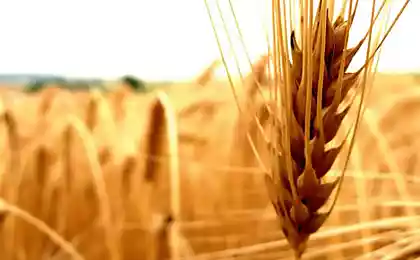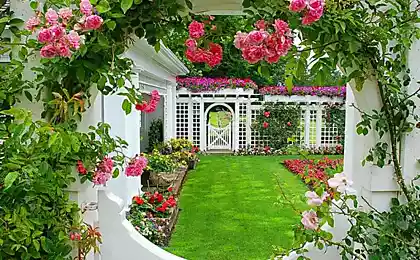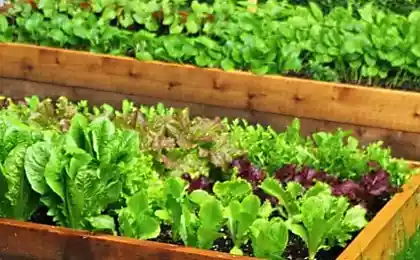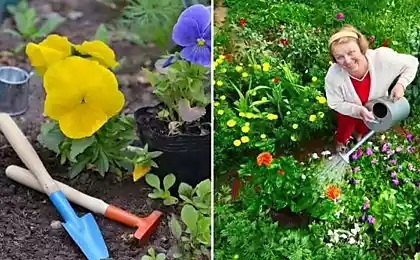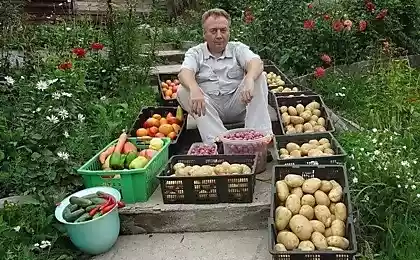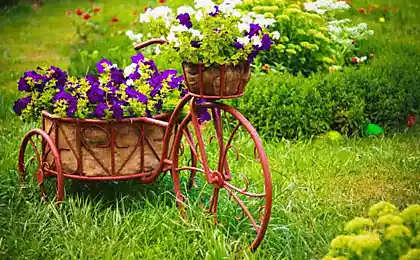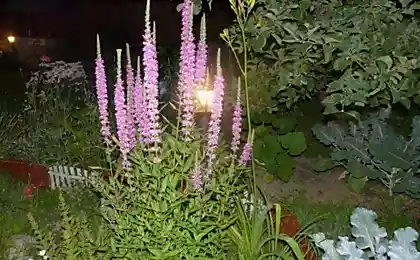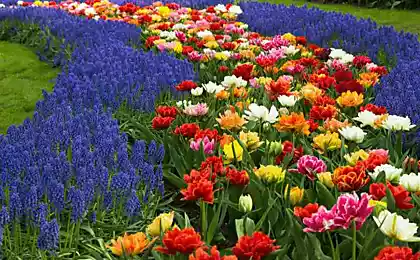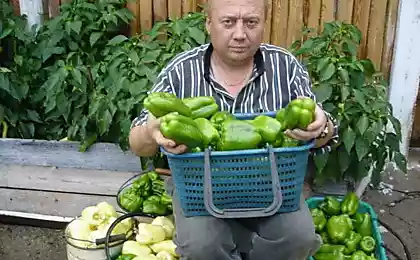238
12 rules of placement of plants in flower beds
In connection with the preparation for the new season, the site has already touched upon a very topical topic for summer residents - the placement of plants on beds, in flower beds, reservoirs. So, now we will strictly adhere to the 8 rules of placement of plants in the rockarium. And now we will try to learn 12 rules of placement of plants in the most complex in its structure element of the cottage - flower garden or mixboarder.
When compiling a floral composition, the harmony of forms, colors and height of plants is very important.
Depending on the appearance, there are dominant (focal), accompanying and filling elements (see the classical scheme of the flower garden). Dominant plants are usually tall plants that attract attention and determine the structure of the flower garden. Accompanying plants are lower plants that fit in flowering time, height and color to the dominants and are planted around them. The gaps between these two groups are filled with decorative plants with a modest color of flowers, or cereals that harmoniously link the floral composition into a single whole.
Stunning effects in flower beds can be achieved when growing not only beautiful flowering, but also decorative and leafy plants. The latter can act as restrained, soothing elements, attract attention with an unusual bizarre shape or texture of leaves, make up a picturesque colorful composition, thanks to the spectacular coloring (motley forms that are now very popular).
Especially valuable are decorative leafy plants with a noticeable aroma (Melissa medicinal ‘Aurea’, ‘All Gold’, ordinary oregano ‘Aureum’, ‘Aureum Crispum’, ‘Gold Tip’, medicinal sage ‘Aurea’, ‘Icterina’, ‘Kew Gold’, ‘Tricolor’, etc.). They are planted in the corners of the cottage, near benches, gazebos. When compiling compositions from ornamental deciduous plants, it is important to combine not only the color, but also the shape of the leaves. For example, elongated leaves look good next to cirrus, and large, round - with pointed.
It is convenient when the basis of the flower garden are perennial plants. This reduces the amount of annual planting. The intervals between perennials are filled with annual plants, the species composition of which can change from year to year at will and create new compositions.
A special group of plants in the flower garden are spring-blooming ephemeroids with a short cycle of above-ground development (crow's onion yellow, primrose, spring cleans). A feature of ephemeroid species is the death of leaves soon after flowering. Therefore, the places of their accumulation during this period are noticeably bare and require additional decoration. This can be done by planting other plants, which is better produced during the period when the dying leaves are completely yellowed, but still remain on the surface of the soil, so as not to damage the underground organs. Another way is the placement of small groups of ephemeroids in containers, which after the flowering of plants are dug out, and pilots plant in empty places. Areas occupied by ephemeroids that bloom in autumn (saffron sowing), usually do not need decoration after their flowering, because at this time the aerial part of most other plants dies.
1 rule Plants are planted taking into account their height: in two-sided flower beds - tall plants are located in the center, in one-sided and mixboarders - from low (in the foreground) to high (far plan) with a gradual decrease from the far plan to the foreground.
2 rule When placing tall plants in the center of the flowerbed, their height relative to the soil level at the edge of the flowerbed should not exceed 1/3 of its diameter. At the same time, if lianas on supports (pyramids, wigwams, trelliages) are used as tall plants, their height should not exceed 1/2-2/3 of the diameter of the flowerbed.
3 rule Low, cushioned or protruding perennials are planted in the foreground.
4 In the stepwise arrangement of plants in the rattles, the highest of them should not exceed in height 1 width of one-sided rattles and 2/3 width of bilateral ones. On average, their height should be from 1/4 to 1/2 of the width of the slave.
5 In an irregular flowerbed, mixboarder, plants are planted asymmetrically and in a chessboard order, leaving space for their growth.
6 rule Ephemeroids planted in groups, the size of which depends on the size of the flower garden. In small areas, groups of 3-5 or clusters of 10-20 specimens will be spectacular, in larger compositions it is possible to create color spots from several dozen of these plants.
7 rule Blossoming in spring bulbs are never planted in the first row, their place in the middle of the flowerbed or in the background so that the leaves that die after flowering are hidden under developing perennials.
Rule 8 Focus plants are planted in small groups or one by one, accompanying plants are planted in groups with an odd number.
9 When developing color compositions, do not get carried away with their number, because overload will quickly begin to irritate, especially in a small country.
Rule 10 The range of plants for flower beds, working beds, mixboarders is preferably selected so as to ensure continuous flowering for a long period of time.
11 Plants in compositions should have similar environmental requirements.
12 rule The approximate consumption of planting material per 1 m2 will be: pilots (perennials) with a height of 100-200 cm - 3-5, a height of 50-90 cm - 5-7, a height of 20-40 cm - 7-11, ground cover - up to 35, bulbous - 12-25.
And in conclusion, I want to note that a neat, finished look to each, especially the regular flower garden will give well-marked boundaries. For this purpose, special curb plants (evergreen or floral) are used or non-living material is used. Of great importance is the timely removal of faded or shriveled parts of plants, as well as good care (watering, fertilizing), which any flower garden will turn into a fabulous corner.
Source: www.7dach.ru
When compiling a floral composition, the harmony of forms, colors and height of plants is very important.
Depending on the appearance, there are dominant (focal), accompanying and filling elements (see the classical scheme of the flower garden). Dominant plants are usually tall plants that attract attention and determine the structure of the flower garden. Accompanying plants are lower plants that fit in flowering time, height and color to the dominants and are planted around them. The gaps between these two groups are filled with decorative plants with a modest color of flowers, or cereals that harmoniously link the floral composition into a single whole.
Stunning effects in flower beds can be achieved when growing not only beautiful flowering, but also decorative and leafy plants. The latter can act as restrained, soothing elements, attract attention with an unusual bizarre shape or texture of leaves, make up a picturesque colorful composition, thanks to the spectacular coloring (motley forms that are now very popular).
Especially valuable are decorative leafy plants with a noticeable aroma (Melissa medicinal ‘Aurea’, ‘All Gold’, ordinary oregano ‘Aureum’, ‘Aureum Crispum’, ‘Gold Tip’, medicinal sage ‘Aurea’, ‘Icterina’, ‘Kew Gold’, ‘Tricolor’, etc.). They are planted in the corners of the cottage, near benches, gazebos. When compiling compositions from ornamental deciduous plants, it is important to combine not only the color, but also the shape of the leaves. For example, elongated leaves look good next to cirrus, and large, round - with pointed.
It is convenient when the basis of the flower garden are perennial plants. This reduces the amount of annual planting. The intervals between perennials are filled with annual plants, the species composition of which can change from year to year at will and create new compositions.
A special group of plants in the flower garden are spring-blooming ephemeroids with a short cycle of above-ground development (crow's onion yellow, primrose, spring cleans). A feature of ephemeroid species is the death of leaves soon after flowering. Therefore, the places of their accumulation during this period are noticeably bare and require additional decoration. This can be done by planting other plants, which is better produced during the period when the dying leaves are completely yellowed, but still remain on the surface of the soil, so as not to damage the underground organs. Another way is the placement of small groups of ephemeroids in containers, which after the flowering of plants are dug out, and pilots plant in empty places. Areas occupied by ephemeroids that bloom in autumn (saffron sowing), usually do not need decoration after their flowering, because at this time the aerial part of most other plants dies.
1 rule Plants are planted taking into account their height: in two-sided flower beds - tall plants are located in the center, in one-sided and mixboarders - from low (in the foreground) to high (far plan) with a gradual decrease from the far plan to the foreground.
2 rule When placing tall plants in the center of the flowerbed, their height relative to the soil level at the edge of the flowerbed should not exceed 1/3 of its diameter. At the same time, if lianas on supports (pyramids, wigwams, trelliages) are used as tall plants, their height should not exceed 1/2-2/3 of the diameter of the flowerbed.
3 rule Low, cushioned or protruding perennials are planted in the foreground.
4 In the stepwise arrangement of plants in the rattles, the highest of them should not exceed in height 1 width of one-sided rattles and 2/3 width of bilateral ones. On average, their height should be from 1/4 to 1/2 of the width of the slave.
5 In an irregular flowerbed, mixboarder, plants are planted asymmetrically and in a chessboard order, leaving space for their growth.
6 rule Ephemeroids planted in groups, the size of which depends on the size of the flower garden. In small areas, groups of 3-5 or clusters of 10-20 specimens will be spectacular, in larger compositions it is possible to create color spots from several dozen of these plants.
7 rule Blossoming in spring bulbs are never planted in the first row, their place in the middle of the flowerbed or in the background so that the leaves that die after flowering are hidden under developing perennials.
Rule 8 Focus plants are planted in small groups or one by one, accompanying plants are planted in groups with an odd number.
9 When developing color compositions, do not get carried away with their number, because overload will quickly begin to irritate, especially in a small country.
Rule 10 The range of plants for flower beds, working beds, mixboarders is preferably selected so as to ensure continuous flowering for a long period of time.
11 Plants in compositions should have similar environmental requirements.
12 rule The approximate consumption of planting material per 1 m2 will be: pilots (perennials) with a height of 100-200 cm - 3-5, a height of 50-90 cm - 5-7, a height of 20-40 cm - 7-11, ground cover - up to 35, bulbous - 12-25.
And in conclusion, I want to note that a neat, finished look to each, especially the regular flower garden will give well-marked boundaries. For this purpose, special curb plants (evergreen or floral) are used or non-living material is used. Of great importance is the timely removal of faded or shriveled parts of plants, as well as good care (watering, fertilizing), which any flower garden will turn into a fabulous corner.
Source: www.7dach.ru



